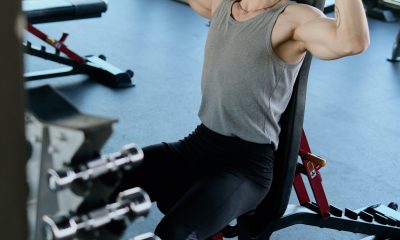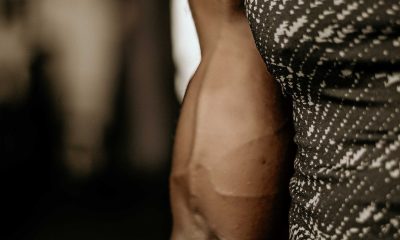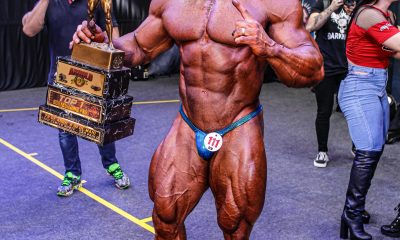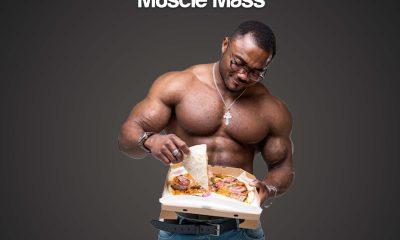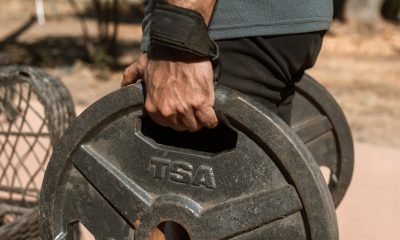Bodybuilding
Shoulder Injuries in Bodybuilding
Shoulders are often injured while performing exercises for building muscle mass. With the aim to fully develop the deltoid muscle, bodybuilders periodically varied movements that increase the risk of injury.
Deep in the shoulder joints, there are small muscles that work exclusively on biomechanics. They do not resist heavy standing or decline bench presses.
They have minimal growth potential. Bundles of these muscles can easily get hurt. In addition, during exercise, these muscles rub against bone blade appendage. Hence, this causes extreme pain and inflammation. Many experienced bodybuilders live for years on analgesics. However, sports medicine knows how to prevent injuries rotators.
Read More: What Are the Risks of Using Steroids?
Our shoulder joints have a high degree of freedom in all three planes. If we compare with the hip, both perform the same function of the joint - control the movement of the limbs. As you've just seen, each in their own way. Limited mobility of the hip joint is not accidental. It is a condition of its strength. The mobility of the shoulder joints obtained at the cost of their complex costing. But all that is complex can be easily broken.
As we said shoulder injury is the most common in bodybuilding. Moreover, most of the injuries affect a group of four small muscles, hidden deep in the shoulder joint. They are called the rotator-cuff of shoulder muscles.
These muscles are not able to develop a sufficient force for the beach bar. However, their role is important. Rotator- cuff muscles are an extra insurance. They have a strong foundation, as they should not break away from the blades, even under enormous loads. The upper tendons of muscles are reduced practically to a point. This hardly strengthens the link between them.
You have to know that any movement of the hands is accompanied by a reflex contraction of the muscle-rotators. They become shorter and more press in the humerus in response groove joint. Thus, rotation of the hands is less dangerous as the joint increase the strength.
There are many factors that may cause shoulder injuries. Most common of them being the following: the excess burden on the shoulders, genetic defects shoulder joints, old injuries and incorrect technique of exercise execution.
When there is a pain in the shoulder, the cause is difficult to understand even for an expert. Obviously, a doctor can help with special techniques to accurately diagnose the injury-rotators muscles, but to unravel its nature is possible only during a long and expensive test using the methods of functional diagnostics.
Read More: Can Steroids Stop You From Having Kids
According to sports professionals, shoulder pain is most common among athletes with experience. This happens because of decrease of free space under the acromion shoot. As a result, the muscles and their tendons begin to rub against each other, causing pain.
Another cause of pain is tendonitis. These are inflammation of the tendons, muscles rotators. Usually, they occur in microdamage places caused by too much tension of tendons or friction on the hard tissues of the joint.
Another disease associated with pain is called bursitis. This is an acute or chronic inflammation of the so-called bursa. Bursa is located under the muscle-tendon rotator, passing over the acromion ridge blade. It should prevent the ridge crest to cut tendon. Excessive pressure on the bursa leads to further damage and inflammation.
There are cases when pain is caused by a partial rupture of the muscle-rotators. All the causes of pain, except the last, seem insignificant. There are many people who think that this is an inflammation, nothing serious and do not pay attention to it, continuing exercising even they feel pain. They take analgesic and continue training. In this case, the inflammation worse, and the pain will increase.
Since the new load does not give the source of inflammation to heal, it becomes chronic. Pain disappear, then occurs again. The worst thing is that chronic inflammation is practically impossible to treat using drugs, although at the beginning you can help a simple aspirin or ibuprofen tablet.
It is very important to say that doctors categorically prohibit to exercise when you feel pain in your shoulder. The fact is that the inflammation weakens tendon tissue. So the next training on analgesics can turn into a tragedy: inflammation of the tendon may tear.
If you suddenly feel a pain in the shoulder, training should be immediately stopped. It is highly recommended do not do any exercises that concern the area of injury during two weeks. There are some quick measures that have to be taken in case of shoulder injuries.
First of them is about applying a cold pack on the area of injuries. Do this procedure in the first 2-3 days after you get injured for 20 minutes. Applying cold will successfully fight inflammation. Take medications. It is not only about taken a drug that relieves pain, but drugs that fight inflammation too.
These include drugs from the group of nonsteroidal anti-inflammatory analgesics. In particular, ibuprofen and its analogs, and naproxen. Remember that any drug has side effects. So take ibuprofen or naproxen strictly following the instructions.
Take a pause from your training. The duration of the break depends on the severity of the injury. Sometimes the pain is significantly reduced after 3-4 days of rest. Complete rejection of movements that bother injured shoulder is one of the most effective methods of treatment. Why so? Because the edges of the wound have to be pressed tightly against so the wound starts healing. In case of doing stretching movements, the wound will not be able to heal and will continue to bleed.
The same situation is in case of traumatized muscle-rotators. Immediately after the injury molecular fragments of the destroyed tissue get into the bloodstream and signal the brain about the occurred injury. Brain immediately starts the healing process. In the area of injury rush dozens of enzymes, hormone compounds, blood cells and stem cells. As you see body struggle with the disease by itself.
But if after a week the pain is still acute, then amateur treatment have to be interrupted and you have to do a visit to your physician.
Perform exercise for rotator muscles. Daily stretching and special exercises will keep you away from getting your shoulders injured again. Stretching will make tendons-rotation elastic and less susceptible to rupture. Performing special exercises will help to increase the force of rotators. Their resistance to the load increase, thus the risk of traumatic sprains is greatly reduced.
Keep in mind that once the pain from your shoulder disappears you do not have to come back to the old working weights. Why? because the re-injury will not make you feel pain suddenly. Pain comes late in the evening or the next day. So first try the lightweight and see what happens. If the pain does not appear tomorrow, add some more weight to your training.
It’s true that it will take time to get some progress, but it is guaranteed to lead you to a full recovery. It makes no sense hurry up to your old weights, because injury which is not healed with time pass into a chronic, and this is something you will never want to happen to you. In order to prevent strengthen the muscle-rotators.
In order to avoid getting your shoulder injured were developed some great exercises designed to strengthen the muscles and joints. Include these exercises in your training twice a week and you will prepare an excellent base for building muscle definition with no danger of getting injured your shoulders.
One of these set of exercise is called "The Wall". Perform it this way: press your heels, buttocks, shoulders and head to the wall. The hands should be raised up, bent at the elbows and also pressed the wall.
Exercise consist in the act that staying pressed tagainstthe wall, you should raise up your hands as much as possible. As soon as you reached the maximum point, the elbows should be gradually lowered as low as possible. It will be enough to perform three reps about 15 seconds each of them.
Must Read: Your Blueprint For Building Bigger Shoulders
Shoulder Shrugs Exercise
The starting position is the same as in case of push-ups, your head should be in the line with the spine. Keeping the original position of the body you have to try to reduce the blade as much as possible, and then relax the shoulders, allowing them to sag. Three repetition about 15 seconds is enough for this type of exercise.
Another exercise is called Arnold press alternatives. For this exercise, you will need to use dumbbells. Standing position, legs apart at shoulder width, toes apart, dumbbells held in front of chest, palms facing back.
Must Read: Build Up Trapezius Muscle With Barbells Shrugs
Performed bench with one hand while turning the brush. At the maximum point of benching, palm should be facing forward. Then, carrying traffic in the opposite order, dumbbell should return to its original position. The same must be run with the other hand. In this case, perform three reps for 12 seconds.
Staggered-Stance Lateral Raise Exercise
In the position of standing erect, hold the dumbbells at hip level. Do a step forward and from this position lift dumbbells with your hands. The maximum lifting point is at shoulder level, then let your hands back to the starting position. Special attention must be given to the preservation of balance. Perform three reps about 12 seconds.
Squat with Dumbbells Exercise
Follow this position: feet apart at shoulder-width, toes should be diluted, hands straight with dumbbells at hip level. Exercise is carried out in several stages, first to raise the dumbbells up to shoulder level, then slowly squat is performed, the line thighs should be parallel to the floor line.
Then you need to straighten up, with all the bells also held at shoulder level. Then with an effort to squeeze the dumbbells straight arms, lower their shoulders and then return to the starting position (at the hips). Three reps for 12 seconds is enough for this type of exercise.
Must Read: Goblet Squats For Increasing Lower Body Flexibility And Strength
As you see there are ways to prevent the injury of shoulders. One of them is to build stronger rotator cuff muscles and to avoid overworking shoulder with big weights. A good warming up before getting into training is another great advice that will keep you away from any injuries. And do not forget about the right technique of execution of each exercise. Since a proper execution minimizes the risks of injuries.
Bodybuilding
Understanding Trenbolone-Induced Cough (“Tren Cough”)

Trenbolone, a potent anabolic steroid, can sometimes cause “tren cough”—a sudden and intense coughing episode shortly after injection. Although not exclusive to Trenbolone, it is more commonly associated with this substance due to its highly irritant nature.
 Click Here To Buy 1-Test Cyp 100 by Nakon Medical
Click Here To Buy 1-Test Cyp 100 by Nakon Medical
Mechanisms Behind Tren Cough
Solvent and Carrier Irritation
Trenbolone formulations often include volatile solvents like benzyl alcohol or benzyl benzoate, which may irritate lung tissues when absorbed quickly into systemic circulation.
Prostaglandin Release
Trenbolone promotes increased production of prostaglandins, particularly PGF2α. This compound triggers contraction in the smooth muscles of the lungs, leading to bronchoconstriction and coughing.
Micro-Oil Embolism
Tiny oil droplets from an injection can reach capillaries and travel to the lungs, causing mild embolic reactions that lead to temporary oxygen deprivation and coughing.
Histamine and Mast Cell Activation
For some individuals, Trenbolone triggers histamine release and mast cell activation, mimicking an allergic response and causing bronchospasms and cough reflexes.
Related Article: Best Syringes for Steroid Injection on Amazon
Using Salbutamol (Albuterol) to Manage Tren Cough
- Salbutamol, a widely-used β2-adrenergic receptor agonist, can alleviate tren cough symptoms by:
- Relaxing bronchial muscles, easing spasms that cause coughing.
- Inhibiting prostaglandin effects, reducing bronchoconstriction associated with PGF2α.
- Opening airways, preventing severe respiratory restrictions in susceptible individuals.
Application Methods
Inhaler (Optimal)
Take 1–2 puffs of salbutamol (100–200 mcg) 5–10 minutes before a Trenbolone injection. If coughing occurs afterward, additional puffs can swiftly resolve the issue.
Oral Tablets (Moderate)
Consuming 2–4 mg tablets 30–60 minutes before injection offers slower, longer-lasting relief but may be less effective than inhalation methods.
Nebulizer (Severe Cases)
For individuals with frequent episodes, nebulized doses of 2.5 mg salbutamol can provide substantial relief.
Preventive Measures to Reduce Tren Cough Risk
- Inject slowly to minimize systemic absorption and irritant effects.
- Split doses to lower reaction severity with smaller quantities.
- Opt for ventrogluteal injection sites, which have fewer blood vessels, reducing oil embolism risk.
- Choose lower-concentration solutions to lessen irritation, as higher concentrations (e.g., Tren Ace 200 mg/ml) are more likely to provoke reactions.
What Other Steroids Can Induce Coughing?
Here's a curated list of peptides, SARMs, and PEDs that may potentially cause coughing or respiratory irritation in bodybuilders and fitness enthusiasts:
Peptides
IGF-1 LR3 (Insulin-like Growth Factor): Known for its anabolic effects, IGF-1 LR3 can occasionally cause mild respiratory irritation due to systemic absorption.
TB-500 (Thymosin Beta-4): While rare, improper injection techniques or high doses may lead to transient coughing episodes.
GHRP-6 (Growth Hormone-Releasing Peptide): This peptide can stimulate histamine release, potentially leading to bronchospasms and coughing.
SARMs (Selective Androgen Receptor Modulators)
RAD-140: (Testolone) Some users report throat irritation or coughing, often attributed to solvents used in liquid formulations.
YK-11: Known for its myostatin-inhibiting properties, YK-11 may cause mild respiratory discomfort in sensitive individuals.
LGD-4033 (Ligandrol): Though uncommon, some users experience coughing due to carrier solvents or allergic-like reactions.
PEDs (Performance-Enhancing Drugs)
Boldenone Undecylenate (Equipoise): This injectable steroid can cause “Equipoise cough,” similar to tren cough, due to oil embolism or irritant solvents.
Testosterone Suspension: The water-based formulation may lead to coughing episodes if injected improperly or absorbed rapidly.
Nandrolone Decanoate (Deca-Durabolin): While less common, coughing can occur due to histamine release or systemic irritation.
More Tips to Minimize Coughing Risks
- Use proper injection techniques to avoid embolic reactions.
- Opt for lower-concentration solutions to reduce irritant effects.
- Consider antihistamines or bronchodilators for individuals prone to respiratory sensitivity.
Read More: Joint Stiffness: How to Manage It While on AAS
Are There Alternatives to Cough-inducing Steroids?
Here are some alternatives to cough-inducing steroids that can provide similar anabolic effects while minimizing respiratory irritation:
Peptides
IGF-1 LR3 (Insulin-like Growth Factor)
Promotes muscle growth and recovery without the irritant properties of certain steroids.
TB-500 (Thymosin Beta-4)
Enhances tissue repair and reduces inflammation, making it a safer option for recovery.
BPC-157 (Body Protection Compound)
Known for its healing properties, it supports muscle repair and joint health.
SARMs (Selective Androgen Receptor Modulators)
RAD-140 (Testolone)
Provides significant muscle-building effects with fewer systemic side effects compared to traditional steroids.
LGD-4033 (Ligandrol)
Boosts lean muscle mass and strength without the risk of respiratory irritation.
MK-677 (Ibutamoren)
Stimulates growth hormone release, aiding in muscle growth and recovery.
Natural Alternatives
Turkesterone
A plant-based ecdysteroid that supports muscle protein synthesis and recovery.
Ecdysterone
Another natural compound that mimics anabolic effects without the harsh side effects.
Creatine Monohydrate
Enhances strength and muscle mass through improved energy production during workouts.
Other Options
Human Growth Hormone (HGH)
Promotes muscle growth and fat loss, though it requires careful monitoring due to potential side effects.
Testosterone Boosters
Natural supplements like D-Aspartic Acid or Tribulus Terrestris can help optimize testosterone levels for muscle growth.
SARMs Alternatives
Legal and safer versions of SARMs are available, offering similar benefits without the risks associated with traditional SARMs.
Overall
We have explored the phenomenon of "tren cough," a sudden, intense coughing episode often caused by Trenbolone injections due to factors like solvent irritation, prostaglandin release, micro-oil embolism, or histamine activation. Preventive measures such as using salbutamol (via inhaler, oral tablets, or nebulizer), injecting slowly, splitting doses, and opting for lower-concentration solutions were highlighted.
Additionally, alternative compounds to tren cough-inducing steroids were discussed, including peptides like IGF-1 LR3 and TB-500, SARMs such as RAD-140 and LGD-4033, and natural options like Turkesterone, ecdysterone, and creatine. These alternatives provide anabolic effects while minimizing respiratory side effects. The conversation also underscored the importance of proper injection techniques and thoughtful compound selection to reduce risks.
Bodybuilding
Mastering Bodybuilding in 2025: Top Fitness Tips for Success

Bodybuilding is more than just a sport; it's a lifestyle that requires dedication, discipline, and a thorough understanding of fitness principles. As the world of fitness continues to evolve, bodybuilders must stay updated with the latest trends, techniques, and scientific advancements to achieve their goals. In 2025, several innovative approaches are redefining bodybuilding. Here are essential fitness tips for bodybuilders to excel this year.
Read More: Bodybuilder Winter Clothing: Staying Warm and Stylish
Embrace Technology-Driven Workouts
In 2025, technology plays a significant role in bodybuilding. Wearable devices, fitness apps, and virtual reality (VR) training are now integral components of an effective workout regimen.
Wearable Devices
Modern wearables track everything from heart rate and sleep patterns to muscle activation and caloric expenditure. Utilize these devices to monitor your progress and make data-driven adjustments to your training and nutrition plans.
Fitness Apps
Leverage fitness apps for customized workout plans, progress tracking, and virtual coaching. Many apps now incorporate artificial intelligence to provide personalized feedback and recommendations.
Virtual Reality Training
VR technology offers immersive workout experiences, allowing bodybuilders to simulate different training environments and scenarios. This can enhance motivation and add variety to your routine.
Focus on Functional Strength
While hypertrophy (muscle growth) remains a primary goal, functional strength is gaining importance. Functional strength training improves overall performance, reduces the risk of injury, and enhances daily activities.
 Check Out Our1 4 Weeks Quality Strength & Lean Muscles
Check Out Our1 4 Weeks Quality Strength & Lean Muscles
Compound Movements
Incorporate compound exercises like squats, deadlifts, and bench presses. These movements engage multiple muscle groups and joints, promoting balanced strength development.
Core Stability
Prioritize exercises that strengthen the core, such as planks, Russian twists, and leg raises. A strong core supports better lifting mechanics and reduces the risk of lower back injuries.
Optimize Nutrition for Muscle Growth and Recovery
Nutrition is the cornerstone of successful bodybuilding. In 2025, the focus is on personalized nutrition plans tailored to individual needs and goals.
Protein Intake
Ensure adequate protein intake to support muscle repair and growth. Aim for 1.6 to 2.2 grams of protein per kilogram of body weight per day, depending on your training intensity and goals.
 Click Here to Buy SynthaTrope By SynthaPharma
Click Here to Buy SynthaTrope By SynthaPharma
Nutrient Timing
Pay attention to nutrient timing to maximize muscle recovery and growth. Consume protein and carbohydrates within 30 minutes post-workout to replenish glycogen stores and kickstart muscle repair.
Supplements
Utilize supplements wisely. Creatine, branched-chain amino acids (BCAAs), and omega-3 fatty acids are popular choices for enhancing performance and recovery.
Prioritize Mental Health and Mindfulness
Mental health is increasingly recognized as a critical component of overall fitness. Incorporating mindfulness practices can improve focus, reduce stress, and enhance performance.
Meditation
Incorporate meditation into your daily routine to reduce stress and improve mental clarity. Mindfulness meditation can enhance your mind-muscle connection during workouts.
Visualization
Use visualization techniques to mentally rehearse your workouts. Visualizing successful lifts and achieving your goals can boost confidence and motivation.
Rest and Recovery
Prioritize rest and recovery to prevent burnout and overtraining. Ensure you get 7-9 hours of sleep per night and incorporate rest days into your training schedule.
Leverage Advanced Training Techniques
Advanced training techniques can help break through plateaus and stimulate muscle growth. In 2025, several methods are gaining popularity among bodybuilders.
Blood Flow Restriction (BFR) Training: BFR involves restricting blood flow to the muscles during low-intensity exercises. This technique can enhance muscle growth and strength without the need for heavy weights.
Eccentric Training: Focus on the eccentric (lowering) phase of exercises. Eccentric training can stimulate greater muscle damage and growth compared to traditional concentric movements.
Periodization: Implement periodization into your training plan. Varying the intensity, volume, and type of exercises can prevent plateaus and ensure continuous progress.
Incorporate Recovery and Mobility Work
Recovery and mobility are essential for preventing injuries and maintaining optimal performance. In 2025, bodybuilders are paying more attention to these aspects of training.
Foam Rolling and Myofascial Release: Use foam rollers and massage balls to release muscle tightness and improve flexibility. Regular myofascial release can reduce soreness and enhance recovery.
Stretching: Incorporate dynamic stretching before workouts and static stretching after workouts. Stretching improves range of motion and prevents muscle imbalances.
Cryotherapy and Hydrotherapy: Explore recovery techniques like cryotherapy (cold therapy) and hydrotherapy (water therapy) to reduce inflammation and accelerate muscle recovery.
Engage in Continuous Learning and Community Building
The fitness industry is constantly evolving, and staying informed is crucial for success. Engage in continuous learning and connect with the bodybuilding community for support and motivation.
Educational Resources: Read books, watch videos, and attend seminars to stay updated on the latest research and trends in bodybuilding.
Community Engagement: Join online forums, social media groups, and local bodybuilding clubs. Sharing experiences and knowledge with fellow bodybuilders can provide valuable insights and encouragement.
Professional Guidance: Consider working with a certified personal trainer or coach. Professional guidance can help you optimize your training and nutrition plans, ensuring you're on the right track.
With your FB Plus subscription or active FB Plus Pass, you now have access to 124 weeks of our most popular workout programs, which typically sell for $10-$30 each. Additionally, our popular 4-week Meal Plan is included. This is on top of the 38 Challenges and Programs that are already available to Plus members.
We've also introduced a new feature that many of you have requested. To assist you in choosing your next program, you can now preview each day of any program from its detail view. This feature lets you see all the included workout videos and content before you schedule it, ensuring you know exactly what to expect.
Conclusion
In 2025, bodybuilding is more than just lifting weights; it's a holistic approach to fitness that encompasses technology, nutrition, mental health, and advanced training techniques. By embracing these fitness tips, bodybuilders can achieve their goals, stay injury-free, and enjoy a fulfilling fitness journey. Remember, consistency and dedication are key to success in bodybuilding. Stay committed, keep learning, and most importantly, have fun on your path to becoming the best version of yourself.
Bodybuilding
Top Video Games for Bodybuilders in 2025

There are several video games that can be great for bodybuilders, combining fitness and fun! Here are some of the best options:
Ring Fit Adventure (Nintendo Switch)
The game uses the Ring-Con and Leg Strap to guide you through various exercises and adventures. It's a fun way to get a full-body workout while playing a game.
Fitness Boxing 2: VR Boxing Remastered (PlayStation VR)
It offers a full-body boxing workout with a variety of punches and combos. It's a great way to improve your fitness while enjoying a virtual boxing experience.
Must Read: Marvel-Inspired Training Clothing on Amazon
Just Dance 2024
This popular dance game gets you moving to the beat with a variety of songs and dance routines. It's a fun way to burn calories and improve your coordination.
Zumba Fitness
Burn It Off (Nintendo Wii): This game offers a fun and energetic Zumba workout, perfect for those who enjoy dancing and want to get a good cardio workout.
Yoga for Beginners
If you're looking for a more relaxing workout, yoga games can help improve flexibility and reduce stress. Many of these games offer guided yoga sessions that you can follow along with.
Gym Tycoon
This game lets you build and manage your own gym, complete with various workout equipment and fitness classes. It's a great way to learn about different exercises and how to create effective workout routines.
The Sims 4: Fitness Stuff Pack
This expansion pack for The Sims 4 adds fitness equipment and activities to the game, allowing you to improve your character's fitness and join the athlete career.
Grand Theft Auto: San Andreas
While not a traditional fitness game, this classic game includes bodybuilding activities that can help your character gain muscle and improve fitness.
Knockout Home Fitness (Nintendo Switch)
This game offers a variety of boxing workouts that can help improve your strength and endurance.
Gym Simulator 24 (PC)
In this simulation game, you can build and manage your own fitness empire, creating workout routines and managing gym equipment.
Let's Get Fit (Nintendo Switch)
This game focuses on pure workouts, allowing you to set programs and follow along with digital trainers for a customized fitness experience.
Beat Saber (VR)
A popular VR game where you slash blocks to the beat of the music, providing an intense full-body workout.
Synth Riders (PlayStation VR)
This game combines freestyle dance and fitness, offering high-tempo tracks and multiplayer modes for a fun and energetic workout.
Yoga Master (PlayStation)
Designed by professional yoga coaches, this game offers a variety of yoga lessons and poses to improve flexibility and reduce stress.
Les Mills Bodycombat (PlayStation VR)
A martial arts-inspired workout game with a range of workout plans and coaching to keep you motivated.
OhShape Ultimate (PlayStation VR)
This game provides a full-body cardio workout with six sessions and two difficulty levels, designed to engage every part of your body.
These games offer a mix of cardio, strength, and flexibility workouts, making them great additions to your fitness routine.
Related Article: Supplemental Breast Milk for Bodybuilders
-

 Steroids2 years ago
Steroids2 years agoShavers and Other Body Grooming Equipment for Bodybuilders In 2023
-

 Steroids2 years ago
Steroids2 years agoChatGPT and Other Avenues to Find Great Bodybuilding Coaches
-

 Steroids2 years ago
Steroids2 years agoBest Oil Recommendations Before Competition for Subtle Shimmer
-

 Steroids2 years ago
Steroids2 years agoPowerlifting Vs Power Building: Find Out the Big Difference and When to Shift Between the Two
-

 Bodybuilding Products1 year ago
Bodybuilding Products1 year agoTelmisartan In Bodybuilding: An Expert’s Advice
-

 Nutrition2 years ago
Nutrition2 years agoEverything Nutritional Food: What’s Too Much Or Too Little
-

 Bodybuilding9 months ago
Bodybuilding9 months agoPrimal Movements: Our Ultimate Guide for Maximum Results
-

 Anabolic Steroids10 months ago
Anabolic Steroids10 months agoJoint Stiffness: How to Manage It While on AAS
-

 Steroids1 year ago
Steroids1 year agoAnadrol Cycle: Benefits, Doses, Alternatives, etc.
-

 Bodybuilding1 year ago
Bodybuilding1 year agoChia Seeds in A Bodybuilder’s Diet: An Expert’s Advice
-

 Bodybuilding9 months ago
Bodybuilding9 months agoHow Effective is Bone Broth for Recovery?
-

 Anabolic Steroids1 year ago
Anabolic Steroids1 year agoLegality of Anabolic Steroids In Latin America
-

 Beginners2 years ago
Beginners2 years agoTren Cycle for Beginners
-

 Steroids11 months ago
Steroids11 months agoOmnitope (Oxytocin)
-

 Bodybuilding1 year ago
Bodybuilding1 year agoHow Much Is Too Much Cardio? Understanding Heart Rate Zones
-

 Steroids10 months ago
Steroids10 months agoSleeping Positions for Effective Muscle Recovery
-

 Bodybuilding1 year ago
Bodybuilding1 year agoCalorie Dumping: A Bodybuilder’s Guide
-

 Bodybuilding9 months ago
Bodybuilding9 months ago2nd Edition of Natural Bodybuilding Competition Facts
-

 Bodybuilding1 year ago
Bodybuilding1 year agoList of FDA-Approved Peptides
-

 Bodybuilding2 years ago
Bodybuilding2 years agoCompetition Prep Cycle for Pro Bodybuilders
-

 Bodybuilding1 year ago
Bodybuilding1 year agoDemystifying Hypertrophy Training
-

 Bodybuilding9 months ago
Bodybuilding9 months agoAre Nootropics a Better Option to AAS?
-

 Steroids5 months ago
Steroids5 months agoOstarine For Beginners: The Ultimate Guide
-

 Anabolic Steroids12 months ago
Anabolic Steroids12 months agoHow Much Do You Know About B-AET? A Fat Burner You’ve Been Missing
-

 Product Reviews12 months ago
Product Reviews12 months agoTop Vitamins for Skin Health


